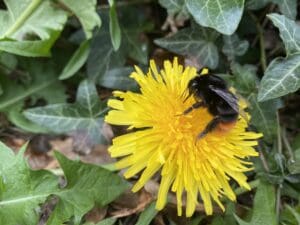Science Manager, Dr Richard Comont, gives us an insight into why we’ve been seeing less bumblebees this year.
As the years roll by, there tends to be one thing that happened during the year that attaches itself as a label. 2020 was the year of Covid, 2022 was the 40°C heatwave. For a lot of people, 2024 was The Year of No Bees.
It all started off so well. Back in early March the skies were blue and queen bumblebees were emerging from their winter dormancy in high numbers – in fact, several species reached record numbers in March or April. But then the wheels came off. In June, volunteers across our BeeWalk network were recording around 11 bumblebees for every kilometre they walked. In a ‘normal’ year, they would be recording 21, almost twice as many. 2024 stood out as the worst June count on record.
Some species were faring even worse. The Red-tailed bumblebee (Bombus lapidarius) is a widespread and common species, understatedly beautiful with a jet-black body and bright red tail. The flight season started well, with around a third more sightings of overwintered queens than usual in March and April. But then – nothing happened.

Red-tailed bumblebee © Jade Oliver
In a normal year, those queens would find themselves a nest site and start producing workers in May, with numbers ramping up in June and staying high through July and August, workers gradually give way to males and new queens. During 2024 they just never managed to get going. In June, sightings were 83% down. Instead of seeing a Red-tail every 250-300 metres, BeeWalkers were only seeing one individual every two kilometres.
The immediate cause seems to have been the weather. After that burst of early-spring sunshine, the spring and early summer settled down into a pattern of dull, gloomy, damp days interspersed with heavy rain. This makes life incredibly difficult for bumblebees, especially in the early stages of nesting where the queen has to balance finding a nest site, foraging for herself, foraging for her developing offspring, and incubating her brood. Cool, damp weather means the queens spend more energy keeping themselves and their brood warm, which increases the need for foraging but decreases the time available for it.
To make things even more difficult, that foraging would have become more difficult in the poor weather. Food from flowers is less accessible on cold, damp days, especially as flowers close up or get damaged in heavy rain.
Unfortunately, the BeeWalk numbers show that many queens didn’t manage to walk this tightrope and nest successfully.
How can I help bumblebees?
In response to our latest BeeWalk data, we’ve launched an urgent appeal to help secure a future for bumblebees. We can’t control the weather, but we can:
- Make habitats more resilient to climate change
- Influence decision makers to prioritise pollinators, not pesticides
- Lead the fight to secure a future for bumblebees
By donating to our appeal, you’ll be helping to secure a future for our bumblebees.
No comments:
Post a Comment